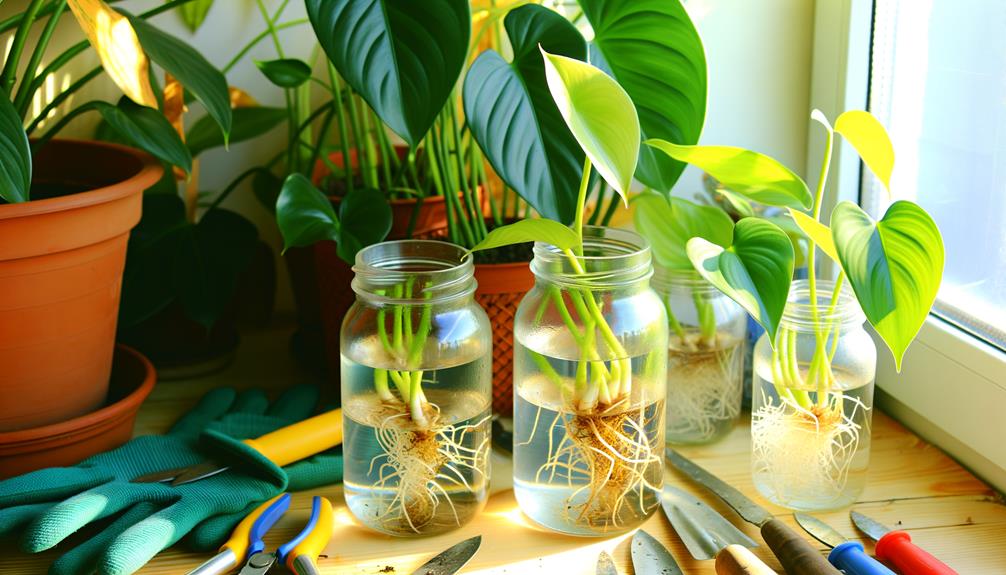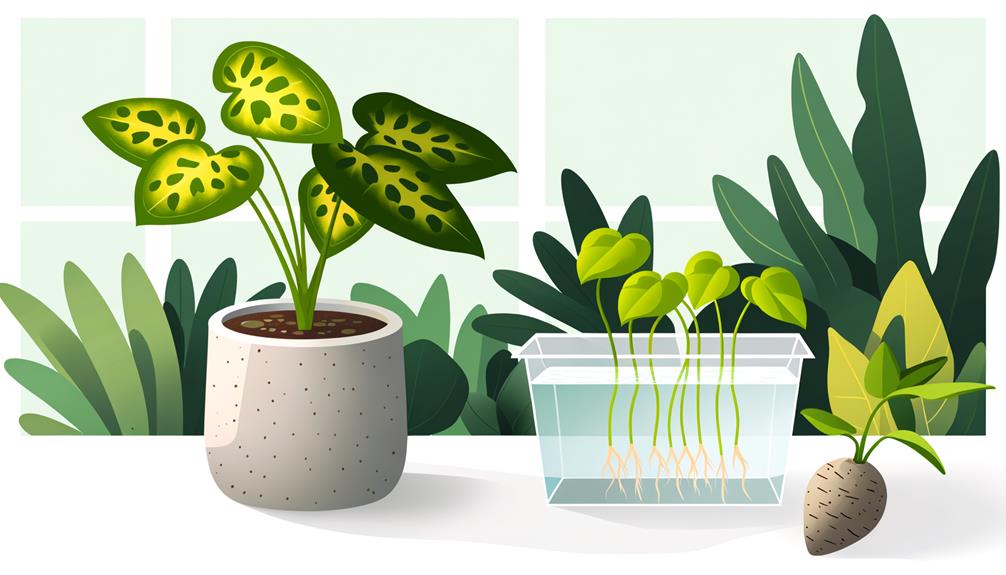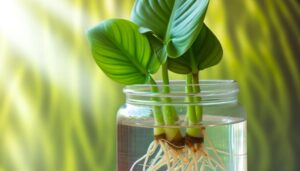Swiss Cheese Philodendron Propagation
To propagate Swiss Cheese Philodendron (Monstera adansonii), begin by selecting a vigorous, disease-free parent plant with robust stems and vibrant leaves. Utilize sterilized pruning shears to take stem cuttings with at least one node.
Choose a well-draining potting mix containing perlite, peat moss, and orchid bark. Opt for propagation during the active growing season in spring or early summer.
Maintain ideal humidity (60-70%) and temperature (65-75°F) and ensure regular monitoring for root development. Changing water consistently aids in root growth, and mature leaves are preferable for successful propagation.
For more intricate details on each step and techniques, further exploration is encouraged.

Key Takeaways
- Choose disease-free parent plants with robust stems and deep green leaves.
- Use sterilized pruning shears or a sharp knife for making precise cuts.
- Propagate during the active growing season in spring and early summer.
- Use a well-draining potting mix with perlite, peat moss, and orchid bark.
- Maintain humidity between 60-70% and temperature between 65-75°F for optimal growth.
Choosing Healthy Parent Plants

Selecting strong and disease-free parent plants is crucial for successful propagation of the Swiss Cheese Philodendron (Monstera adansonii). Begin by examining potential parent plants for signs of vitality. Look for vibrant, deep green leaves that are free from discoloration or necrotic spots, which may indicate fungal infections or nutrient deficiencies.
Inspect stems for robustness and a lack of lesions or rot. Guarantee the plant exhibits vigorous new growth, as this is indicative of overall health. Avoid plants with pests such as spider mites, aphids, or scale insects.
Conduct a thorough root inspection; healthy roots should be white or light tan and firm. By selecting top-notch parent plants, you enhance the likelihood of producing resilient, thriving progeny.
Necessary Tools and Supplies
For successful propagation of the Swiss Cheese Philodendron (Monstera adansonii), precise cutting tools such as sterilized pruning shears or a sharp knife are essential to minimize plant tissue damage and prevent infection.
Equally important is the selection of an appropriate potting medium, with options ranging from well-draining soil mixes to sphagnum moss, each offering unique advantages for root development.
Ensuring ideal conditions for propagation requires careful consideration of these essential tools and materials.
Cutting Tools Needed
A successful propagation of the Swiss Cheese Philodendron requires the use of sterilized, sharp cutting tools to guarantee clean cuts and minimize the risk of infection. Securing the tools are properly prepared is paramount for the health of the plant.
Key tools include:
- Pruning Shears: These should be sharp and clean for precise cuts.
- Scalpel or Sharp Knife: Ideal for making delicate incisions without causing undue stress to the plant.
- Isopropyl Alcohol (70% or higher): Used for sterilizing cutting tools before and after use to prevent the transmission of pathogens.
The precision and cleanliness of cuts directly impact the plant's ability to root and thrive, making the selection and preparation of cutting tools a critical step in successful propagation.
Potting Medium Choices
Having confirmed that the cutting tools are properly prepared, attention must now be directed towards selecting a suitable potting medium to support the successful rooting and growth of the Swiss Cheese Philodendron cuttings. Ideal mediums include a high-quality, well-draining potting mix composed of equal parts perlite, peat moss, and orchid bark. This blend guarantees sufficient aeration, moisture retention, and drainage, crucial for root development.
Additionally, incorporating activated charcoal can prevent mold and mildew, enhancing root health. Necessary tools and supplies include a clean, sterilized pot with drainage holes, a watering can, and rooting hormone to stimulate root formation. Ensuring the potting medium remains consistently moist but not waterlogged will greatly improve the success rate of propagation.
Best Time for Propagation

The best time for propagating the Swiss Cheese Philodendron, scientifically known as Monstera adansonii, is during its active growing season, typically in spring and early summer.
Ensuring that the parent plant is healthy and experiencing vigorous growth will maximize the success rate of cuttings. Perfect cutting conditions include selecting a stem with at least one node and a few healthy leaves, and performing the cut in the morning when the plant's turgor pressure is highest.
Optimal Growing Season
Propagating Swiss Cheese Philodendron (Monstera adansonii) is most successful during the spring and early summer months when the plant's growth rate is at its peak. During this period, the increased availability of sunlight and warmer temperatures create favorable conditions for root development and overall plant vigor. This timing aligns with the natural growing cycle of Monstera adansonii, thereby enhancing the likelihood of successful propagation.
Key benefits of propagating during this opportune growing season include:
- Enhanced Root Development: Warmer temperatures accelerate root growth.
- Increased Photosynthesis: Longer daylight hours boost the plant's energy production.
- Natural Growth Cycle: Aligns with the plant's intrinsic growth patterns, ensuring robust health.
Adhering to this seasonal timing maximizes propagation success rates and promotes healthy new growth.
Ideal Cutting Conditions
Selecting cuttings for propagating Swiss Cheese Philodendron requires ensuring the parent plant is in excellent health and that the chosen nodes are robust and mature. The best time for taking cuttings is during the active growing season, typically spring through early summer. This period aligns with increased metabolic activity, thereby enhancing root development and shoot proliferation.
Cuttings should be taken in the morning when plant hydration status is at its peak. Employ sterilized, sharp pruning shears to make clean cuts just below a node, ensuring each cutting contains at least one node and one or two leaves. Avoid cuttings from flowering sections, as these may drain resources necessary for vegetative growth. Properly selected cuttings enhance propagation success rates significantly.
Taking Stem Cuttings
To successfully propagate a Swiss Cheese Philodendron, one must begin by identifying a healthy mother plant and preparing sterilized cutting tools. The mother plant should exhibit robust growth, vibrant leaves, and no signs of disease. Sterilize pruning shears or a sharp knife using isopropyl alcohol to prevent pathogen transmission. Select a vine with multiple nodes and aerial roots.
Key considerations include:
- Node Count: Confirm each cutting has at least one node, as this is crucial for root development.
- Leaf Presence: Cuttings with one or two leaves are more likely to photosynthesize effectively, promoting faster root growth.
- Cut Angle: Make a clean cut at a 45-degree angle to maximize the surface area for rooting.
This foundational step sets the stage for successful propagation.
Preparing the Cuttings

Begin by submerging the cut ends of the stem cuttings in a rooting hormone to enhance root development and increase the chances of successful propagation. This step is crucial as the rooting hormone contains auxins, which are plant growth regulators that stimulate root formation.
Make sure the cuttings are dipped in the hormone for at least 10 seconds, allowing ample absorption. After dipping, gently shake off any excess powder or liquid hormone to prevent clumping.
It is advisable to use sterile, sharp pruning shears to make clean cuts, minimizing tissue damage and reducing the risk of pathogen infection. Additionally, trim off any lower leaves, leaving only a few at the top to reduce water loss through transpiration.
Rooting in Water
For successful rooting of Swiss Cheese Philodendron cuttings in water, select cuttings with at least two nodes and a few healthy leaves.
Make sure the water is replaced every 5-7 days to prevent stagnation and promote the best root development.
Monitoring the water quality is essential, as it can impact both the rate and health of root formation.
Cutting Selection Tips
Selecting the best cutting for successful rooting in water involves identifying a healthy stem with at least one node and several mature leaves. Nodes are vital as they house the meristematic tissues from which roots will emerge. Confirm the stem shows no signs of disease or pest infestation.
When selecting a cutting, consider the following criteria:
- Node Presence: Choose a stem that has at least one visible node, as this is necessary for root development.
- Leaf Maturity: Opt for cuttings with a few mature leaves to facilitate photosynthesis and energy production.
- Stem Health: Inspect the stem for any discoloration or damage, ensuring it is sturdy and free from pathogens.
These factors greatly improve the likelihood of successful propagation.
Water Change Frequency
To maximize root development and prevent the growth of harmful bacteria, change the water every two to three days when rooting Swiss Cheese Philodendron cuttings. Fresh water maintains an ideal oxygenation level, essential for root initiation and elongation. Stagnant water can harbor pathogens such as Pythium and Phytophthora, which cause root rot.
Use dechlorinated water to avoid chlorine-induced stress on the cuttings. Monitor water levels to guarantee the nodes remain submerged, facilitating root emergence. Employ a transparent container to observe root progress and detect any early signs of bacterial or fungal growth.
Rooting in Soil

Rooting Swiss Cheese Philodendron cuttings in soil requires selecting a well-draining potting mix to prevent waterlogging and maximize aeration for root development. A mixture containing equal parts perlite, peat moss, and orchid bark is ideal for ensuring top-notch drainage and nutrient availability.
When inserting the cutting into the soil, make sure at least one node is buried to facilitate root initiation.
Key considerations include:
- Soil Composition: Use a mix of perlite, peat moss, and orchid bark.
- Node Positioning: Ensure nodes are buried to promote rooting.
- Watering: Maintain consistent moisture without oversaturation.
These steps are critical for successful propagation, providing a foundation for the cutting to establish a robust root system and eventually thrive as an independent plant.
Creating Optimal Conditions
Establishing best conditions for Swiss Cheese Philodendron propagation requires precise control of environmental factors like light, humidity, and temperature. Optimal light exposure includes filtered, indirect sunlight, preventing leaf scorch while promoting photosynthesis.
Use a humidity level of about 60-70%, achievable through regular misting or a humidity tray. Maintaining a temperature range between 65-75°F (18-24°C) is essential for root development and overall plant health.
Soil moisture should be consistently monitored, ensuring it remains moist but not waterlogged, to facilitate rooting. Using a sterile, well-draining propagation medium, such as a mix of perlite and peat moss, further enhances success rates.
These conditions together create a favorable environment for the Swiss Cheese Philodendron's successful propagation.
Monitoring Growth

Upon successful propagation, attentive monitoring of the Swiss Cheese Philodendron's growth is essential to guarantee healthy development and early detection of potential issues. Observing the plant's physical indicators can provide valuable insights into its health.
Regularly inspect the foliage for signs of discoloration, wilting, or pest infestation. Maintain consistent humidity and light levels to prevent stress on the plant.
Leaf Color:
Healthy leaves should be vibrant green; yellowing could suggest nutrient deficiencies or overwatering.
Root System:
Check for root rot by gently examining the roots; they should be white and firm.
Growth Rate:
Monitor for steady new growth; stagnation might indicate environmental imbalances or disease.
Such careful attention will promote robust and thriving philodendrons.
Transplanting New Plants
Carefully transplanting newly propagated Swiss Cheese Philodendrons is essential to guarantee their successful establishment and continued growth.
Begin by selecting a well-draining potting mix, ideally an aroid-specific blend containing perlite, orchid bark, and peat moss.
Gently remove the rooted cuttings from their propagation medium, ensuring minimal root disturbance.
Prepare a container with adequate drainage holes and partially fill it with the potting mix.
Position the cutting at an appropriate depth, ensuring the roots are well-covered, but not buried too deeply.
Firmly press the soil around the base to eliminate air pockets and provide stability.
Water thoroughly to settle the soil, and place the plant in an environment with indirect light and high humidity to promote acclimatization.
Common Mistakes to Avoid

To successfully propagate Swiss Cheese Philodendrons, it is important to avoid common mistakes like excessive watering, inadequate light, and incorrect soil composition.
Excessive watering can result in root rot, which can harm the plant's health. Make sure the growing medium retains moisture without getting waterlogged by using a well-draining potting mix.
Additionally, providing inadequate light can hinder photosynthesis, slowing down growth. Place the cuttings in a bright, indirect light to encourage strong development.
Finally, incorrect soil composition can impede root establishment. An ideal mixture includes peat, perlite, and pine bark to offer necessary aeration and nutrients.
- Excessive Watering: Avoid waterlogged soil to prevent root rot.
- Inadequate Light: Provide bright, indirect light for excellent growth.
- Incorrect Soil Composition: Use a well-draining mixture of peat, perlite, and pine bark.
Conclusion
The propagation of Swiss cheese philodendron, when executed with precision and adherence to botanical principles, presents a compelling opportunity to expand one's collection of this unique species.
By meticulously selecting healthy parent plants, employing the correct techniques for stem cuttings, and maintaining ideal conditions for growth, successful propagation is within reach.
However, vigilance is required to avoid common pitfalls. The anticipation builds—will the careful propagation efforts culminate in flourishing new plants, or will unforeseen challenges impede the journey to botanical success?






